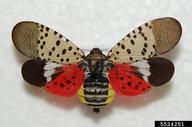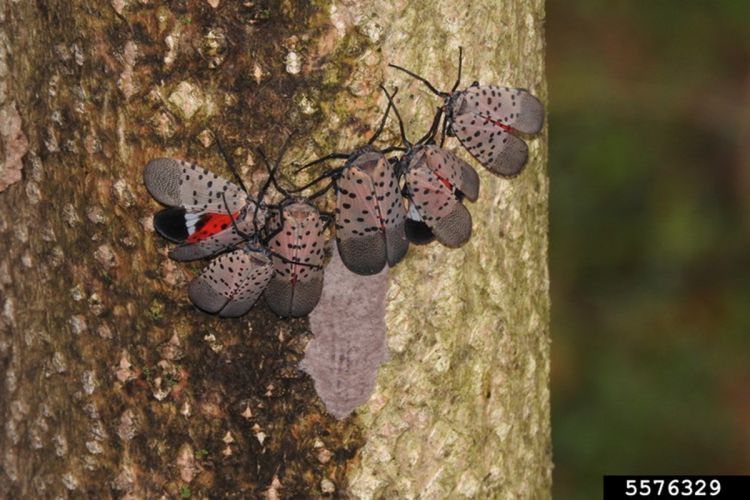Spotted lanternfly
The spotted lanternfly (Lycorma delicatula) in an exotic invasive planthopper known to feed on over 100 host plants including economically important crops from the horticultural, forestry, ornamental and viticulture industries as well as native trees and plants. Damage caused by the spotted lanternfly decreases yields, reduces plant health and impacts produce quality. The spotted lanternfly is not found in Australia.
Description
The adult spotted lanternfly is approximately 25 mm long and 12 mm wide. It has light brown forewings with black spots, and a speckled band at the outside edge The hindwings are bright red with black spots with a white and black band at the front . The abdomen is bright yellow with a horizontal black stripe on each segment (Figure 1).


Eggs are approximately 25 mm long and laid in flat, yellowish-brown masses of 35 to 50 eggs covered in a waxy dull brownish secretion designed to protect the eggs from predators and climatic conditions (Figure 2). Eggs are preferably laid on smooth surfaces, either natural or artificial.
Nymphs grow from 3.1 mm when newly hatched up to 12 mm during their four developmental stages. The first to third nymphal stages are black with white spots (Figure 3) whereas the fourth stage is bright red with black and white markings (Figures 3 & 4).


Feeding damage
The spotted lanternfly causes damage through feeding by using its piercing-sucking mouthpart to puncture host tissue. Feeding causes wilting, leaf curling and dieback. Communal feeding results in wounds on the plant and the discharge of sugar-rich liquid on the stems, branches and trunk of the host which attracts other insects such as bees, wasps and ants and promotes the growth of sooty mould fungus. The wounds also provide entry points for secondary pathogens.
Hosts
The garden tree-of-heaven (Ailanthus altissima) is the preferred host of late instar and adult spotted lanternflies, while grape is the hardest hit economically important crop. Other commercial hosts include almonds, pomefruit, stonefruit and blueberries and walnut. Forestry trees such as birch, oak, poplar, pine and sycamore are also impacted. Early-stage nymphs are not strong enough to penetrate woody tissue so feed on new growth and annual plants. .
Lifecycle
The spotted lanternfly has one generation per year. Eggs are laid in autumn on smooth surfaces and will overwinter until spring. Early stage nymphs will emerge in spring and early summer and will moult four times before reaching maturity. Adult spotted lanternflies first appear in summer and continue to be seen through to autumn when mating occurs and egg masses are produced. Large numbers of adults can be seen gathering on tree trunks at dawn and dusk, in late summer to early autumn. Early stage nymphs feed on smaller plants and vines, and on any new growth on trees and shrubs. Fourth stage nymphs feed on woody plant tissue like the adults.
Distribution
The spotted lanternfly is native to China, Vietnam, and India and is now also confirmed in Korea (2004), Japan (2008), and parts of the USA (2014 and 2020).
Spread
The spotted lanternfly is spread long distances through human-assistance transport of all life stages, especially egg masses which are adept at attaching to any surface. Egg masses have been found on shipping containers, vehicles, machinery, nursery stock, fresh produce, cut flowers and foliage, wooden products and travellers’ luggage. Spotted lanternflies are poor fliers, rarely flying more than 10 to 50 metres at a time. However, they are strong jumpers and will to walk short distances to infest adjacent produce or hosts.
More information
Reporting an unusual plant insect pest or disease
Report any unusual plant pest or disease immediately using our online reporting form or by calling the Exotic Plant Pest Hotline on 1800 084 881. Early reporting increases the chance of effective control and eradication.
Please take multiple good quality photos of the pests or damage to include in your report where possible, as this is essential for rapid pest and disease diagnosis and response.
Your report will be responded to by an experienced staff member, who may seek more information about the detection and explain next steps.
Report online
Image credits
Figures 1 & 3. Richard Gardner, Bugwood.org
Figure 2 & 4. Lawrence Barringer, Pennsylvania Department of Agriculture, Bugwood.org.